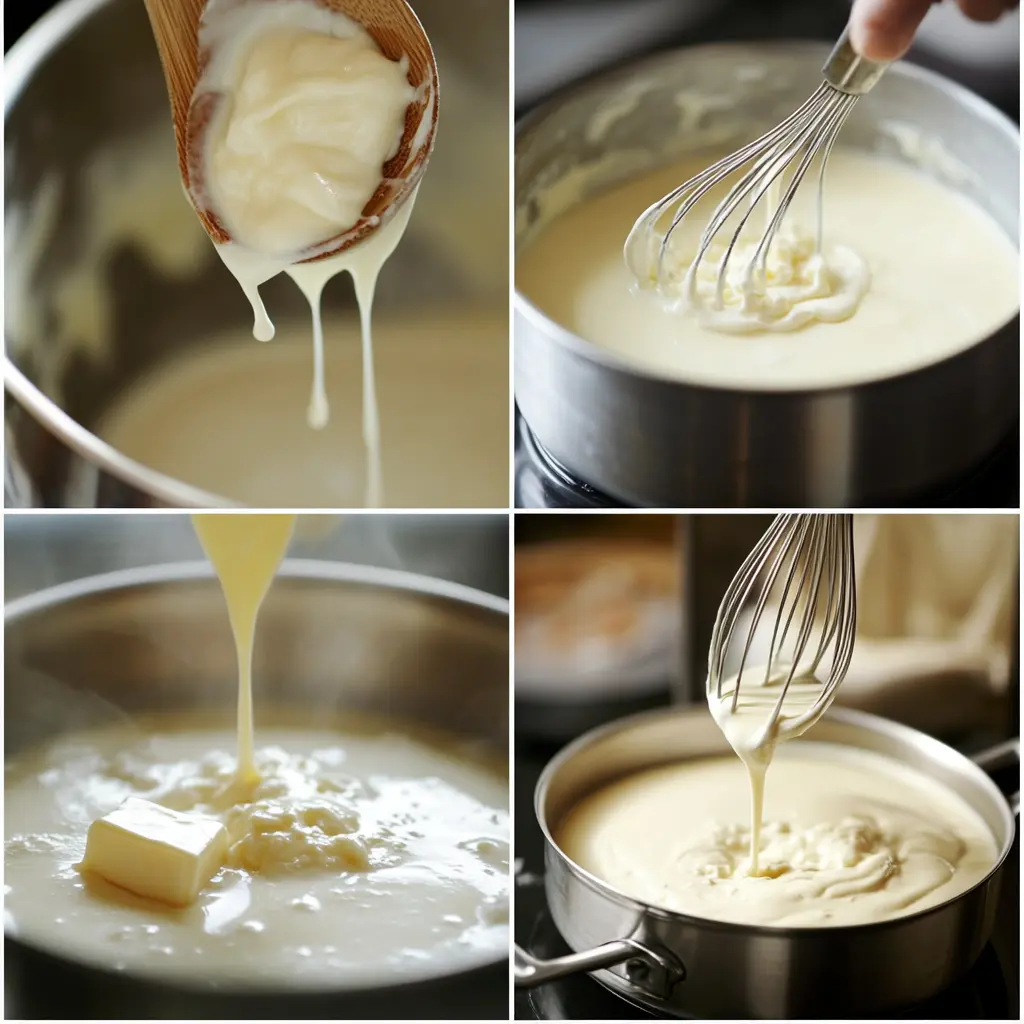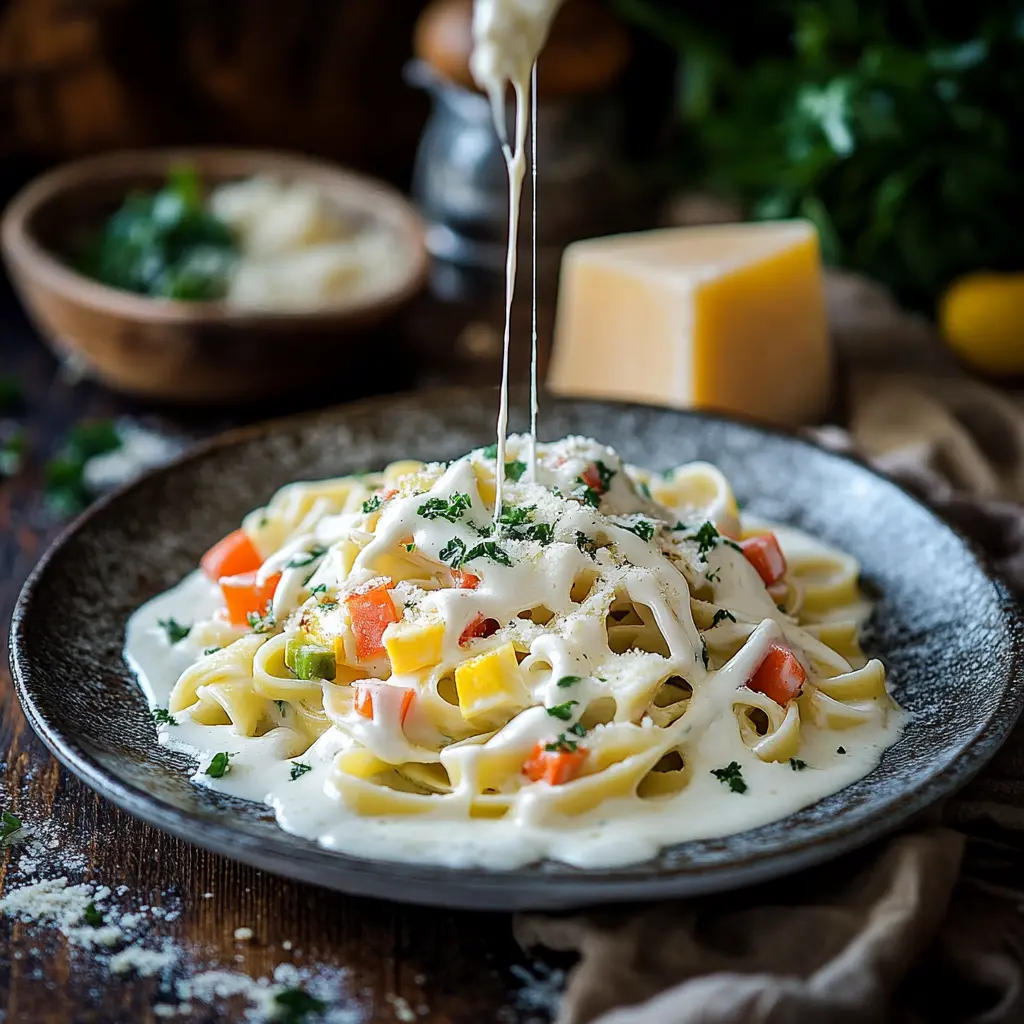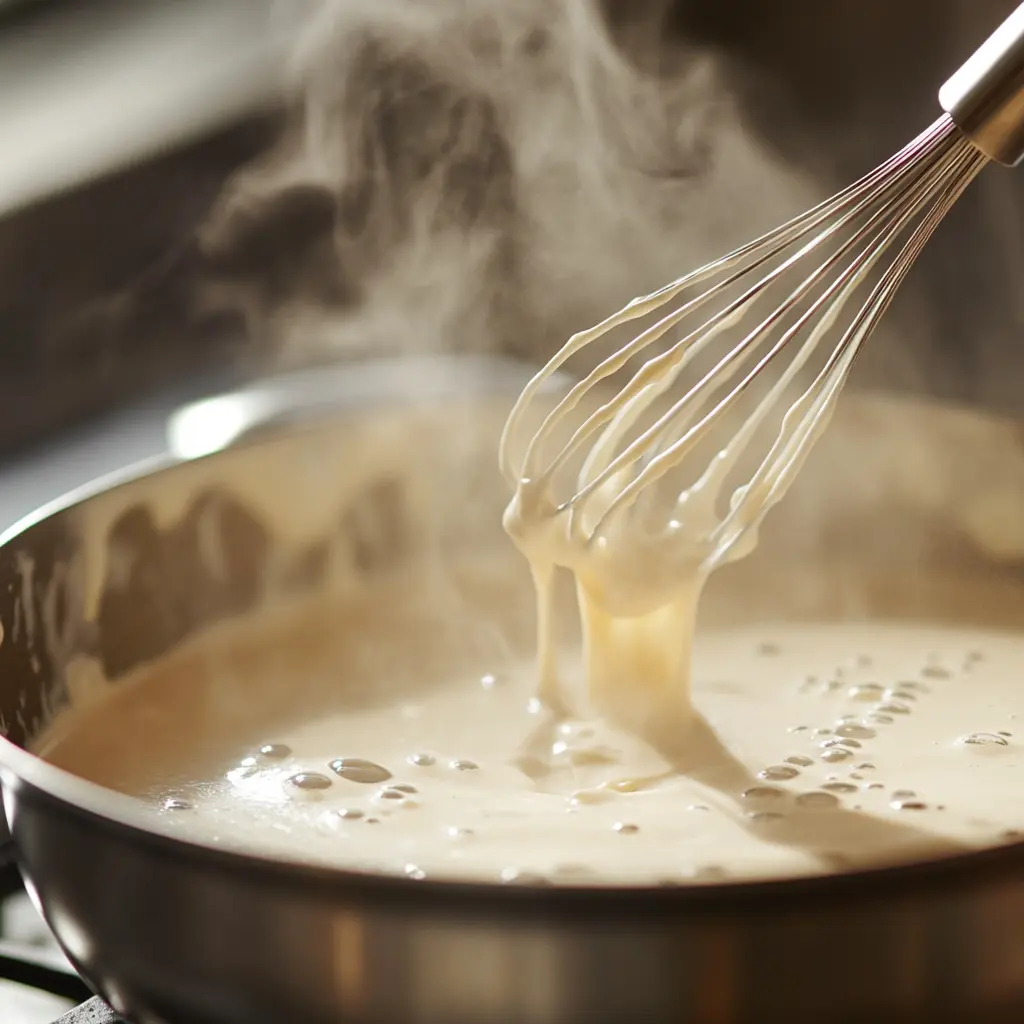White sauce, also known as Béchamel sauce, is a game-changer in the kitchen. Whether you’re whipping up a quick pasta dish, layering a creamy lasagna, or preparing a vegetable gratin, this silky, versatile sauce can take your cooking to the next level. It’s easy to make, uses pantry staples, and forms the base for many other sauces.
In this article, I’ll guide you through everything you need to know about how to make white sauce, from selecting the right ingredients to perfecting the texture. Along the way, we’ll explore variations, creative uses, and pro tips for mastering this classic sauce.
What is White Sauce?
White sauce is a smooth, creamy sauce made with three simple ingredients: butter, flour, and milk. Known as Béchamel sauce in French cuisine, it’s a fundamental component of countless recipes around the world. This sauce forms the base for other favorites like cheese sauce or creamy garlic variations, and trust me, once you master it, the possibilities are endless!
Origin and History of White Sauce
Ever wondered where white sauce got its name? Well, it hails from France, where it’s called Béchamel sauce. Named after Louis de Béchamel, a chief steward in the 17th century, this iconic sauce became a staple in French cuisine. It was later adopted by chefs worldwide, thanks to its versatility. Now, whether you’re cooking Italian pasta or making casseroles, you’ll often find Béchamel in the spotlight.
What Makes White Sauce Special?
So, what’s the magic behind this sauce? It all starts with a roux, a simple mixture of butter and flour, cooked until slightly golden. Add milk, whisk like you mean it, and voilà – you’ve got a velvety sauce that can transform any dish.
What’s even better? You can customize it effortlessly! Add garlic for depth, sprinkle in cheese for richness, or toss in herbs for a fresh twist. Whether you like it simple or fancy, white sauce has your back.
Stay tuned for the next part, where I’ll share the exact ingredients you need to make the perfect white sauce – and tips to pick the best ones!
Ingredients Required for White Sauce Recipe
The beauty of white sauce lies in its simplicity. With just a handful of pantry staples, you can whip up a creamy, velvety sauce that elevates any dish. But, as they say, the devil is in the details. Choosing the right ingredients ensures you achieve the perfect texture and flavor every time. Let’s break it down!
White Sauce Ingredients – Everything You Need
To make the classic white sauce recipe, you’ll need the following:
- Butter – 2 tablespoons (unsalted works best)
- All-purpose flour – 2 tablespoons (the thickening agent)
- Milk – 1 cup (whole milk is ideal for a creamier texture)
- Salt – to taste
- Black pepper – a pinch (for subtle warmth)
- Optional add-ins: Ground nutmeg, garlic powder, or shredded cheese
Choosing the Right Ingredients
- Butter: Always opt for unsalted butter to control the saltiness of your sauce. If you don’t have butter, a neutral cooking oil can substitute, but nothing beats the flavor of real butter.
- Flour: All-purpose flour is the go-to for making the roux (a blend of butter and flour). If you’re gluten-sensitive, you can substitute with gluten-free flour. Just ensure it has the same thickening power.
- Milk: Whole milk provides the creamiest consistency. If you want a lighter version, skim milk works, but the sauce won’t be as rich. Need a vegan alternative? Almond, soy, or oat milk can do the trick.
- Seasoning: Salt and black pepper are your basics, but nutmeg adds a classic French touch that balances the flavors beautifully. For a punchier taste, garlic powder or fresh herbs like thyme can enhance the sauce.
- Optional Additions: If you’re feeling fancy, a sprinkle of shredded cheese can transform this basic white sauce into a rich, gooey cheese sauce for pasta or nachos.
With the ingredients sorted, let’s dive into the fun part – making the perfect white sauce step by step!
How to Make White Sauce (Béchamel) – Step-by-Step Guide
Now that you’ve got your ingredients ready, it’s time to roll up your sleeves and make the magic happen. Follow these easy steps to create a flawless white sauce every single time.

Step 1: Preparing the Roux
- Place a saucepan over medium heat and add butter. Let it melt completely, but keep a watchful eye – you don’t want it to burn!
- Once melted, add the all-purpose flour to the butter.
- Stir constantly using a whisk or wooden spoon. The mixture will form a thick paste, known as a roux.
- Cook the roux for 1-2 minutes until it turns light golden. This step removes the raw flour taste but keeps the sauce smooth.
Pro Tip: Avoid rushing this step. If the roux burns, it will ruin the flavor of your white sauce.
Step 2: Adding Milk Gradually
- Slowly pour in milk while whisking continuously. Adding milk in stages prevents lumps from forming.
- Keep whisking until the roux fully dissolves into the milk. Your sauce will start to thicken as it heats.
Pro Tip: Use room-temperature milk for better results. Cold milk can shock the roux and create lumps.
Step 3: Seasoning the Sauce
- Once the sauce reaches a smooth, thick consistency, season with salt and black pepper to taste.
- If desired, add a pinch of nutmeg for a classic French flavor.
Step 4: Adjusting the Consistency
- If the sauce feels too thick, add a splash of milk and whisk until it loosens up.
- For a thicker sauce, let it simmer for an extra minute while whisking.
Pro Tip: The sauce will naturally thicken as it cools, so aim for a slightly thinner consistency if serving immediately.
Step 5: Enhancing the Flavor (Optional)
Want to add a little flair to your white sauce? Here are some quick ideas:
- Cheese Sauce: Add shredded cheddar or Parmesan for a rich, cheesy version. Perfect for pasta or casseroles!
- Garlic Herb Sauce: Stir in garlic powder and freshly chopped parsley for a fragrant twist.
- Spiced White Sauce: Add a pinch of paprika or cayenne for a subtle kick.
And that’s it! You’ve successfully made a silky, lump-free white sauce. Whether you’re pouring it over pasta, layering it in lasagna, or using it as a dip, this sauce is guaranteed to impress.
Stay tuned for the next section, where I’ll show you creative variations and ways to use your white sauce recipe in everyday dishes!
Delicious Variations of the Classic White Sauce
Now that you’ve mastered the basic white sauce, it’s time to have a little fun with it. The beauty of Béchamel lies in how easily you can tweak it to create exciting new flavors. Whether you’re craving cheese, herbs, or something vegan, these variations have got you covered.
Cheese Sauce
Transforming your white sauce into a cheesy delight is as easy as it gets.
- How to Make It: Once your sauce is smooth and creamy, stir in shredded cheese – cheddar, Parmesan, or mozzarella work perfectly. Let it melt over low heat until the sauce turns gooey.
- Where to Use It: Drizzle over pasta, nachos, or steamed vegetables for a quick upgrade.
Pro Tip: A dash of mustard powder or a pinch of paprika can enhance the cheesy flavor even further.
Garlic Herb White Sauce
For a fragrant and flavorful twist, infuse your sauce with garlic and herbs.
- How to Make It: Add minced garlic to the melted butter while making the roux. Stir in fresh herbs like parsley, thyme, or basil once the sauce thickens.
- Where to Use It: Perfect for white sauce pizza, creamy mashed potatoes, or even grilled chicken.
Vegan White Sauce
Yes, you can enjoy a dairy-free white sauce that’s just as creamy!
- How to Make It: Substitute butter with olive oil or vegan margarine and use plant-based milk like almond, soy, or oat milk. Add nutritional yeast for a cheesy flavor.
- Where to Use It: Ideal for vegan pastas, casseroles, and as a sauce for roasted veggies.
Uses of White Sauce in Recipes
If you’ve ever wondered where you can use white sauce, the answer is practically everywhere. This versatile base works beautifully in countless dishes, adding richness and depth to simple ingredients. Let’s explore some popular and creative ways to use it.

Popular Dishes Featuring White Sauce
- Creamy White Sauce Pasta: Toss cooked pasta with white sauce, sautéed vegetables, and a sprinkle of Parmesan cheese for a quick, comforting meal.
- Lasagna Layers: Béchamel sauce is a key component in lasagna, creating creamy layers between the pasta sheets and meat or vegetable filling.
- Vegetable Gratin: Coat steamed vegetables like broccoli, cauliflower, or carrots with white sauce, top with breadcrumbs and cheese, then bake until golden and bubbly.
- White Sauce Pizza: Replace tomato sauce with garlic herb white sauce for a creamy, savory base. Top with cheese, chicken, mushrooms, or spinach for a delicious twist.
Creative Ideas for White Sauce
- Sandwich Spread: Use thickened white sauce as a creamy spread for sandwiches or wraps.
- Baked Casseroles: Combine cooked rice, shredded chicken, and vegetables with white sauce. Top with cheese and bake for an easy, one-dish dinner.
- Dipping Sauce: Serve as a dip for breadsticks, roasted potatoes, or even grilled meat.
The possibilities are endless! From everyday meals to fancy dinner parties, white sauce is your secret weapon for turning simple ingredients into something special.
Tips for Perfect White Sauce
Even though making white sauce is straightforward, a few tricks can help you nail it every time. Here are some pro tips to keep in mind:
- Whisk Consistently: Keep whisking as you add milk to the roux. This prevents lumps and ensures a smooth sauce.
- Room-Temperature Milk: Cold milk can cause the roux to seize up, leading to lumps. Always use milk at room temperature.
- Low and Slow: Cook the sauce over low to medium heat. Rushing it can burn the butter or flour.
- Adjust the Thickness: If the sauce is too thick, add a splash of milk. If it’s too thin, let it simmer a little longer while whisking.
- Season at the End: Adding salt or other spices too early can alter the sauce’s consistency. Wait until it thickens before seasoning.
Bonus Tip: If you’re aiming for a super-smooth sauce, strain it through a fine mesh sieve after cooking. It’ll remove any stubborn lumps and give you a restaurant-quality finish.
With these tips and tricks, your white sauce recipe will always be on point – silky, lump-free, and delicious. Stay tuned as we dive into common mistakes to avoid so your sauce turns out perfect every time!
Common Mistakes to Avoid When Making White Sauce
While white sauce seems simple, a few slip-ups can ruin its smooth and creamy texture. Luckily, avoiding these common mistakes is easy if you know what to watch out for.
1. Burning the Butter or Flour
- What Happens: Cooking the butter-flour mixture (roux) for too long or at high heat can burn it, giving your sauce an unpleasant, bitter taste.
- How to Avoid It: Always cook the roux over low to medium heat and stir constantly. Look for a light golden color – not brown.
2. Adding Milk Too Quickly
- What Happens: Pouring all the milk at once can cause lumps to form. Lumps are the ultimate white sauce disaster.
- How to Avoid It: Gradually add milk in small portions, whisking constantly to ensure it blends smoothly with the roux.
3. Not Whisking Enough
- What Happens: Stopping too soon allows flour or milk to clump together, leading to a grainy sauce.
- How to Avoid It: Keep whisking until the sauce thickens completely and reaches a smooth texture. Consistency is key!
4. Overcooking or Undercooking the Roux
- What Happens: An undercooked roux leaves a raw flour taste, while an overcooked one darkens and changes the flavor profile.
- How to Avoid It: Cook the flour and butter for 1–2 minutes until the raw smell disappears, but don’t let it darken.
5. Improper Seasoning
- What Happens: Adding seasoning too early or forgetting it altogether makes the sauce bland or inconsistent.
- How to Avoid It: Always season your white sauce at the end. This way, you’ll have control over the taste without altering its consistency.
Frequently Asked Questions About White Sauce Recipe
How Do I Store White Sauce?
Allow the sauce to cool completely, then transfer it to an airtight container. Refrigerate for up to 3 days. Reheat over low heat while whisking to restore its smooth consistency.
Can I Freeze White Sauce?
Yes, you can freeze white sauce. Pour it into a freezer-safe container and freeze for up to 3 months. When reheating, thaw it in the fridge overnight and whisk well while warming.
How Can I Fix Lumpy White Sauce?
If lumps form, don’t panic! Strain the sauce through a fine mesh sieve or use an immersion blender to smooth it out.
What’s the Secret to a Richer White Sauce?
For extra richness, use full-fat milk or stir in a splash of cream. Adding cheese, herbs, or garlic also enhances flavor.
By mastering these simple tips and avoiding common mistakes, your white sauce recipe will always turn out flawless – rich, smooth, and absolutely delicious. Stay tuned for the conclusion!
Conclusion
Mastering the art of white sauce unlocks endless possibilities in your kitchen. Whether you’re preparing a quick weekday pasta, layering a rich lasagna, or experimenting with creative variations like cheese sauce or garlic herb sauce, this creamy classic always delivers. With its simple ingredients and easy-to-follow steps, even beginners can whip up a silky, lump-free sauce like a pro.
By avoiding common mistakes – like burning the roux or adding milk too quickly – and applying expert tips, you can ensure perfect results every single time. Plus, with storage and reheating tricks, your white sauce can be ready whenever inspiration strikes!
Now, it’s your turn to bring this versatile, comforting sauce to life in your favorite recipes. So grab your whisk, gather those ingredients, and let the magic happen. Your culinary journey with white sauce has just begun!

